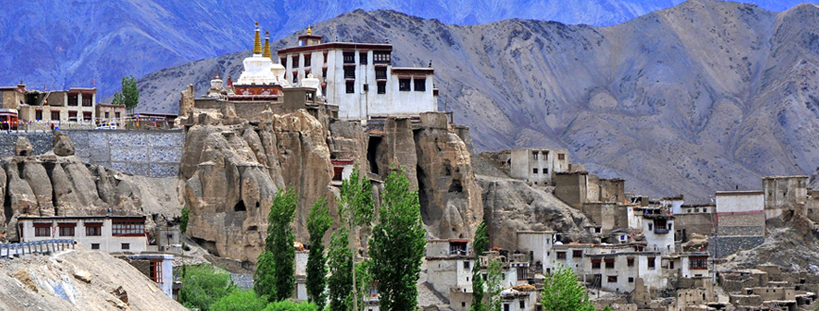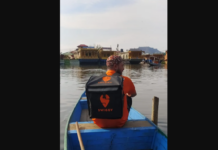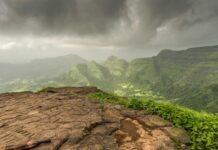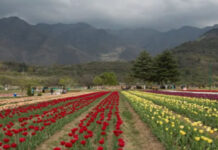Hemis Monastery is the most popular monastery and tourist attraction in Ladakh. Situated some 45 km from Leh city, Hemis is tucked in a mountain on the west bank of the serene river Indus.
The monastery belongs to Dugpa Kargyutpa order or Red Sect of Buddhism and is said to be enriched with a large number of Thangkas or paintings, which are exhibited during one of the famous festivals in Ladakh, Hemis Festival.
In 1630, the monastery was founded by the first incarnation of Stagsang Raspa Nawang Gyatso who was invited to Ladakh by King Singay Namgyal and was given estate throughout the region.
Inside the monastery, a copper gilded statue of Lord Buddha can be see along with various stupas that are said to be made of precious metals like gold and silver.
Some 3 km away, on the side of the mountain above the monastery is a sacred hermitage which is reckoned to have been founded by the great Gyalwa Kotsang. In this hermitage/cave, one can witness his footprint and handprint on the rock.
It is said that the hermitage was found several years prior to Hemis Monastery. There is also a museum in the premises of the monastery, where several ancient religious and historical paintings, weapons, carriers, and even a stuffed vulture pup is exhibited.
THINGS TO DO AND SEE
Hemis Monastery has a beautiful architecture, which is quite interesting to witness. One can pay homage to the two large statues of Lord Buddha and Guru Rimpoche.
Also, there is a museum that exhibits a large collection of Buddhist relics and several ancient items that suggest there existed a rich culture here.

Alchi Monastery, Ladakh
In the lower segment of Ladakh nestles the Alchi, a beautiful village comprising monuments dating to periods. Of these monuments, Alchi Monastery is the oldest and witnesses a good footfall. The monastery was built somewhere between 958 and 1055 AD by the Guru Rinchen Zangpo.
Majestically, this fort sits with pride at the edge of the mountain range overlooking Leh city. General Zorawar Fort is a must visit attraction when you visit the city. Its impressive structure is made from a local type of clay, sun-dried bricks, stones and wooden frames around the edges.
General Zorawar Fort Leh
This fort was home to the “Conqueror of Ladakh” late Zorawar Singh Kahluria who consistently struggled against the Chinese rulers. And even now this major tourist attraction gleams with pride and has been declared as one of the national monuments in India by Archaeological Sites and Remains Act 1958.
Leh Jama Masjid
Leh Jama Masjid sits majestically surrounded by a vibrant culture of the Indo-Tibetans built in 1666-67 AD. Located in the heart of the city, this tourist attraction holds a noble symbol of the Islamic culture. However, this holy place allows only men to enter inside.
Jama Masjid is a major tourist place, noted to be the largest mosque in Ladakh. And this historical mosque in Leh is always crowded by tourists since it is surrounded by the main bazaar. This place also has a Shahi Hamdan Memorial which is made in dedication to Mir Syed Ali Hamdani who was a Muslim Sufi saint.
Shanti Stupa Ladakh
The face of Ladakh Tourism, the white-domed Shanti Stupa was built in 1991 by Japanese Buddhist Bhikshu Gyomyo Nakamura as a part of the Peace Pagoda mission. The stupa is a symbol of the ties between the people of Japan and Ladakh.
Within the stupa, there are relics of the Buddha, enshrined by the 14th Dalai Lama. The stupa is spread over two levels. The first level has a Buddha idol, and the second features relics depicting the “birth” of Buddha, the death of Buddha (Mahanirvana) and Buddha “defeating the devils” while meditating.
Major Festivals

Hemis Monastery becomes alive during the annual Hemis Festival which is celebrated here in early June to honour Guru Padmasambhava.
His birth anniversary falls on the 10th day of the fifth month of the Monkey year of Tibetan calendar. An interesting fact about the day is that it comes once after 12 years. Thus, Hemis celebrates the day with great fervor and enthusiasm.
According to beliefs, celebrating this festival bestows people with good health and spiritual strength. Many musicians play traditional music.
The gala begins with early morning ritual when the tapestry adorned with pearls depicting the image of Guru Padmasambhava is exhibited.
This is then admired and worshipped by all. A major highlight of the festival is the Masked Dance which is known as Cham. These performances are part of Tantric tradition and monks could be seen performing Tantric worship.
HOW TO REACH
By road: The easiest way to reach the Monastery by road is hitting the Manali-Leh Highway if you are traveling by road from Delhi. You can reach Leh also by traveling by Leh-Srinagar Highway if you are traveling from Srinagar, Jammu and Kashmir. JKSRTC and private buses ply within the Ladakh region. You can also take your private vehicle (cars/bikes) to Hemis from Leh.
By air: The nearest airport is Leh Airport, which is well connected with some major airports in India, including New Delhi. From the airport, taxis can be hired to reach the hotel in Leh and then make a day trip to the Hemis Monastery from Leh and back the next day after acclimatization.
By train: The nearest major railway station from Leh is Jammu Tawi, at a distance of 812 km. Taxis can be hired from the railway station to reach Leh over Srinagar-Leh Highway in a three-day journey with overnight halts at Srinagar and Kargil.







